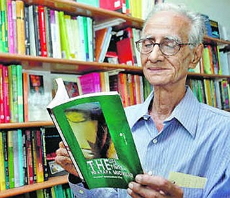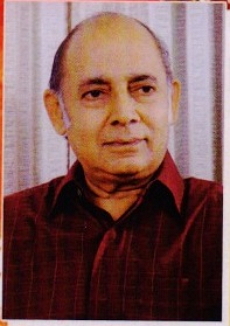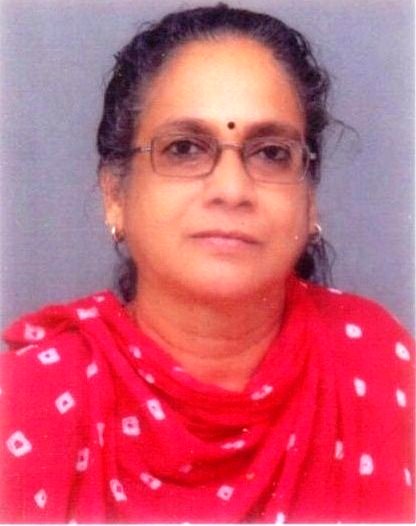
Book Release Function held on the 14th of August, 2015. Veteran Tamil writer Asokamithran’s articles on the various parts of the city of Chennai, as they were several decades ago , initially written and serialized in an Internet Magazine and later on published as a volume by Kavitha Publications. Now, Dr.K.S.Subramanian who has been translating Tamil books of his choice, both prose and poetry into English, mostly without accepting any remuneration (He calls it ‘labour of love!’) has translated this book into English. In Tamil the title is ‘Chennai Nagaram – Oru Paarvayil’ and in English the title is ‘Chennai City: A Kaleidoscope’ and it is now published by Westland Publishers.
About the Author: Asokamitran:
Chennai City: A Kaleidoscope is a compilation of essays penned by veteran writer Asokamitran. He moved to Chennai as a young man of twenty, and having spent more than sixty years in his adopted home now, Asokamitran is well placed to describe the shifts and changes that Chennai has undergone, and he does so beautifully, with his trademark wit, perceptiveness and lucidity. Its waterways, its stations, its lanes and alleys: this is a wonderful ode to city, and a must-read for both, natives of Chennai, and visitors.
Translator Dr.K S Subramanian: Dr.K.S.Subramanian (1937) served the Govt. of Indian (IRAS) for fifteen years (1960-1975) and the Asian Development Bank at Manila for twenty-two years(1975-1998), retiring as a Director. Since his return to India in 1998 he has been involved in literary and social pursuits. He has translated from Tamil to English over 35 literary works encompassing novels, short novels and collections of poetry, short-stories and essays. His Tamil writings on literary, social and developmental themes have appeared in seven volumes. Significant works - Novels, novellas and Tamil New Poetry - have been rendered into English by him. Seven anthologies of modern Tamil poetry have been compiled by him and rendered into English. He has also translated poems of contemporary poets. So far he has translated about 40 per cent of Mahakavi Subramania Bharathis corpus of poetry.
He is a Trustee of Mozhi Trust, a Resource Centre for Tamil Language and Culture, and also of National Agro foundation involved in Rural Development. He is a former member of the Tamil Advisory Board of the Sahitya Akademi.
As part of the Celebration of the Chennai Month the Madras BOOK Club had arranged for the Book Release Function at the Connemara Hotel a few days ago. By way of introducing the book Dr.K.S.Subramanian spoke on the salient features of the Book. Writer Asokamitran spoke on why and how he wrote the articles and held that the book contains his glimpses and impressions of the City of Chennai. There was a discussion on the book and the writer answered the questions in his own humorous way. There should have been more focus on the translator and the translation, I felt.
In his significant volume of modern Tamil Poetry published by the International Institute of Tamil Studies (IITS), thanks to the enthusiastic initiative of Dr.M.Rajendran(Director, IITS) Dr.K.S.Subramanian has observed thus:
“There is evidence of interest in Tamil literature amongst non-Tamils. Many Tamil youngsters in India and abroad, for various reasons, are not convenient with the Tamil language, but are interested in savouring modern Tamil literature at least in English translation.” Indeed true and his translation of this interesting volume of writer Asokamitran would surely delight both Tamils knowing Tamil and not knowing Tamil and also non-Tamils!
Translator Dr.K.S.Subramanian’s article conveying his impressions about the book and which he had read out on the occasion is given below. The address of the publishers is given below: இந்த மின்-அஞ்சல் முகவரி spambots இடமிருந்து பாதுகாக்கப்படுகிறது. இதைப் பார்ப்பதற்குத் தாங்கள் JavaScript-ஐ இயலுமைப்படுத்த வேண்டும்.
Chennai Address:
WESTLAND PUBLISHERS
#61, Silverline,
Alapakkam Main Road,
Maduravoyal,
Chennai 600095
044-66076000-01
இந்த மின்-அஞ்சல் முகவரி spambots இடமிருந்து பாதுகாக்கப்படுகிறது. இதைப் பார்ப்பதற்குத் தாங்கள் JavaScript-ஐ இயலுமைப்படுத்த வேண்டும்.
இந்த மின்-அஞ்சல் முகவரி spambots இடமிருந்து பாதுகாக்கப்படுகிறது. இதைப் பார்ப்பதற்குத் தாங்கள் JavaScript-ஐ இயலுமைப்படுத்த வேண்டும்.
INTRODUCING ‘CHENNAI CITY – A KALEIDOSCOPE’. Dr.K.S.Subramanian

 Friends! I am happy to participate in this pleasant event. I am glad that Westland has come forward to publish my English translation of the eminent writer Ashokamitran’s ‘CHENNAI NAGARAM – ORU PAARVAYIL’ and it is being released under the auspices of Chennai Book Club. My thanks to both these institutions. I would like to recognize the presence of Chokkalingam of Kavitha Publication, who had published the original Tamil book.
Friends! I am happy to participate in this pleasant event. I am glad that Westland has come forward to publish my English translation of the eminent writer Ashokamitran’s ‘CHENNAI NAGARAM – ORU PAARVAYIL’ and it is being released under the auspices of Chennai Book Club. My thanks to both these institutions. I would like to recognize the presence of Chokkalingam of Kavitha Publication, who had published the original Tamil book.
‘CHENNAI CITY – A KALAEIDOSCOPE’ is a collection of beautiful pen pictures of different parts of Chennai City such as Mambalam, T.Nagar, Mylapore, Alwarpet, Adyar, Perambur, Ambathur, Velacheri and Kodambakkam. It covers the evolution of these parts over the second half of the 20th Century. It is marked by a certain fondness and sensitivity.
Ashokamitran moved to Chennai from Secunderabad in 1948. Coincidentally I also moved from Thirunelveli District to Chennai in 1948, as a boy of ten years. Ashokamitran has continuously lived in Chennai ever since. My stay had a break of twenty-two years when I was serving Asian Development Bank in Manila. Even so, when I read the Tamil original, it took me on a journey down the memory lane and the pull of nostalgia was irresistible. I liked it so much that I was tempted to translate it into English. When I shared this thought with Ashokamitran, he readily gave his consent with enthusiasm. My thanks to him for this gracious gesture.
This book is quintessential Ashokamitran. Limpid style, keenness of observation, marshalling details and weaving them seamlessly into the fabric of the narrative, disarming simplicity pregnant with depth and density, a mild satire which does not miss its target but never hurts, and a delicate sense of humour that envelops the entire work like an aroma. I approached this assignment with some trepidation, wondering if I could capture in English the elusive charm of the original. I have enjoyed this work and the English version of the book is before you, possibly not without blemishes.
In introducing this book to you, I believe it could be counter – productive and partly self-serving to be merely effusive in its praise. There is no point in talking about the sweetness and taste of honey. A spoonful would be more eloquent than pages of purple prose. So, I thought it would be appropriate to share with you a few extracts from the book. This is by no means comprehensive, but only a random selection. I believe this would better provide you with the flavour of this work. Let me shift gears and get into the book:
First, T.Nagar: “Those days T.Nagar had only two doctors. One, Chari in Agasthiyar Kovil Street. The other, another Chari in Usman Road. They took care of the T.Nagar residents. There was a Municipal Corporation doctor too. Show him the wound in any part of the body, he would smear the part with a violet lotion. The wound would heal, but the violet wouldn’t disappear in any tearing hurry!”
Another snippet about the railway gate separating T.Nagar and Old Mambalam: “In the 1960s, the railway installed cantilever ‘gates’. Since then, at least two lives were lost each month at these level crossings. Those with well-honed imagination could see ghosts there. “Koo… chikku chikku….” They would be chanting like kids and playing rail-games.”
We all know Ranganathan Street. A seething mass of humanity, all heads and shoulders. Here is Ranganathan Street of some sixty years ago:
“Only three shops in Ranganathan Street: Kumbakonam Utensils Store, Kalyan Store, and a betel leaf–areca nut shop abutting house number 9. If we heard the sound of the train while entering Ranganathan Street, we would be able to run and catch the train. No obstructions in the street.”
Ashokamitran has a soft corner for Mambalam. Mambalam turned into Old Mambalam and later into West Mambalam. We should perhaps wait a little longer for the next change of name. A reference to National Theatre there:
“The only cine theatre there is National. Now, no film shows there. Even when films were screened there, it was no different. Nearing it was a signal for cows and buffaloes to lift their tails. In the entire Chennai City, the place with the richest deposit of natural manure must be the yard in front of National Theatre.”
A dig at Tamil Cinema in relation to YMCA Ground in Saidapet: “Over the past twenty years, dozens of Tamil and Telugu films have been shot on these grounds. If a Tamil film hero had to converse with the heroine, some fifty persons in identical costumes had to appear behind him and dance vigorously, shaking their hands and legs. The heroine was also under a similar compulsion. If fifty persons should simultaneously be shaking their hands and legs, jump up and down and perform somersaults, would not a vast ground be required?”
Theosophical Society was a favourite port of call for tourists to Chennai. This is how Ashokamitran looks at it: “In that vast campus, a few old buildings lie scattered here and there. The other parts look like parks, and also appear like woods. This was a convenient rendezvous for the Spirits in which the Theosophists firmly believed.”
Now the inviolability of the bus ‘fare stage’. ‘Fare stage’ is the bus stop where there is a change in the fare slab. “There is a police station in the Zam Bazaar area too. Whatever the service it had provided or not, over fifty years it has been serving as the bus ‘fare stage’. Get into a bus and demand a ticket to Zam Bazaar and the conductor would immediately ask , “Police Station or Market?” There is but a hand-shaking distance between the two points. But it has assumed the significance of an international border, all because of the bus ‘fare stage’!”
The ever-busy Thiruvanmiyur of today was once an isolated outpost. It comes out graphically in the book: “Thiruvanmiyur is the South-eastern corner of Chennai City. Once Thiruvanmiyur was only an outlying hamlet. A place difficult to reach. Take the Lattice Bridge Road, touch the Lattice Bridge, take a left turn, you will find a dirt track on a rugged terrain interspersed with patches of green fields. Walk half a mile and you reach the western tower of the Thiruvanmiyur temple. The Mada Streets and the pond would then appear in view. East of Sannidhi Street are the hutments of fisher-folk. No buses to Thiruvanmiyur. Can reach the temple only by walk, cycle or a jutka.”
A perceptive picture of Triplicane life:
“While there are five or six large roads in Triplicane, people with their families live only in their tiny portions in the crowded alleys. For ten families, there would be only a single main entry door. They would have arrived at some amazing and simple arrangement on who should lock the entry door in the night and who should open it early morning. They would seldom speak to others in the same building. They would go out to the next lane, chat to their hearts’ content and return.”
The mystique of Chennai postal pincodes: “Velacheri Main Road has many little surprises in store. At one end, it bears the pincode 600 032. This is the pin code of the Governor’s mansion. Travel some distance and it is 600 036. And some more distance, it becomes 600 042!”
Alwarpet and Teynampet had their own ‘twins’. Let’s hear Ashokamitran: “If you refer to Chennai. 18, a question will immediately follow _ Alwarpet or Teynampet. If Alwarpet, a subsidiary question will arise _ New Alwarpet or Village. If Teynampet, they would like to confirm if it was Vellala Teynampet or Vanniya Teynampet. Even today, the pincode 600 018 could raise similar questions.”
Now, to the mushrooming of Nagars and Purams: “No part of Chennai can match Ambathur in terms of the number of small areas with their own distinctive names. Many Purams such as Venkata Puram, Rama Puram, Varadaraja Puram, Krishna Puram. Likewise, many Nagars too. Ram Nagar, Lenin Nagar, Indira Nagar, Nehru Nagar, Sivananda Nagar, Annai Satya Nagar and the list appears to be endless. Only two streets and it will have a separate name.”
Several film and drama artistes lived in a few streets of Royapettah. The author presents a picture with a sting in the tail. The congregation of film and drama artistes has since become a smudged memory. When the drama artistes conducted their evening rehearsals, sound would emerge in good measure from a Pentecostal church nearby and would sound like a decibel competition. The area comprising these four-five streets had a name which could be quite disconcerting. It was called ‘Kolaikaran Pettail’(Murderers’ Area). To my knowledge no murders had taken place there. From a certain point of view, it could well have connoted murder of the fine arts! Ashokamitran takes us on a conducted tour of the Government eye Hospital.
Another old and famous hospital in Egmore is the Eye Hospital. Fifty years ago, it was known to be globally reputed. One cannot enter this hospital with closed eyes. Like the ticket counters for the lowest denomination cinema tickets, there are many narrow rows. Those who buy rice in the better shops should go forward only sideways, on this narrow path. Should also make sure to stand in the correct row. One row for buying the chit, another row to get signature on the chit, yet another row to see the eye-doctor. The doctor opens your eyes and scribbles a prescription. Another row to get the medicines. There is, however, a saving grace. No queue for getting out of the hospital!
The author reaches the Central Station after a tiring journey. It is a signal for one more ordeal _ the journey from the station to home. You can’t choose your jutka. As soon as you get down from the train, a jutka driver would snatch your bed roll and tiffin carrier, run fast an disappear into nowhere. It would be up to you to carry heavy suitcases and bags and go in search of him. Standing near his cart he would yell at you, “Here, Here”. In the midst of all this confusion of a number of jutkas and jutka drivers and throngs of people, another passenger would have placed two or three pieces of luggage in your jutka before you could manage to reach there. Simply because the jutka driver had snatched two pieces of your luggage, you can’t be overly sure that he would take you in his cart. If the other passenger agrees to pay the fare without bargaining, your luggage would be unceremoniously dumped on the ground and the new guy would be elevated to the status of the passenger. In the meanwhile, all the jutkas would get their passengers and disappear quickly. You would be left high and dry.
Jutkas have nearly vanished from the Chennai roads now. Not so, a few decades ago. Here is a heartwarming picture of a frail jutka driver and his emaciated horse: “The relationship between the jutka driver and his horse is special. The driver knows every ache and travail of his horse. The horse has to toil to sustain the lives of the driver and itself. The driver asking the passenger to come to the front or move to the back is all to balance the load landing on the horse. Most jutka drivers engage in lively conversation with their horses. While tending the horse with horsegram and water, the driver would speak fondly to the horse, fondle it, implore it and also seek its forgiveness.”
I can go on and on. But I should stop here. I should leave you with the book to read and savour it.
இந்த மின்-அஞ்சல் முகவரி spambots இடமிருந்து பாதுகாக்கப்படுகிறது. இதைப் பார்ப்பதற்குத் தாங்கள் JavaScript-ஐ இயலுமைப்படுத்த வேண்டும்.
